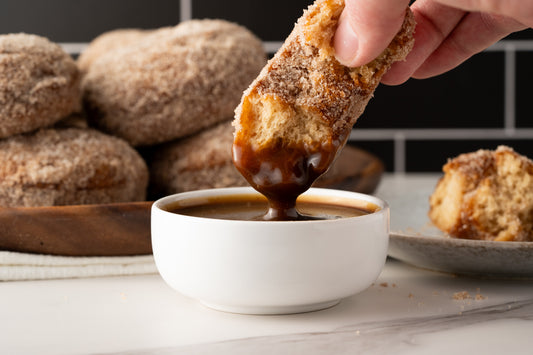Recipe Notes
-
Scone dough can be sticky, but using well-chilled ingredients and keeping the dough cold throughout the process will help. Dust with additional pastry flour as needed to prevent sticking, always brushing away any excess flour to prevent too much extra from being incorporated.

For Cranberry-Orange Scones, substitute dried cranberries and orange zest
Ingredients
- 2½ cups (313g) reclamation gluten-free pastry flour blend
- 3 tbsp (38g) granulated sugar
- 2 tsp (10g) baking powder
- ½ tsp (3.1g) table salt
- 1 large (50g) egg
- 1 cup (240g) heavy cream, chilled
- 1 tsp (5g) vanilla extract (optional)
- 2 tsp citrus zest (optional)
- 6 tbsp (85g) unsalted butter, cold, cut into ½ inch cubes
- ½ cup, heaping (95g) dried fruit, like zante currants or dried cranberries
- additional heavy cream, for brushing
- coarse sparkling sugar, for topping (optional)
Directions
Step 1
Optional: soak the dried fruit in hot water for 10 - 15 minutes, then drain and pat dry with paper towel.
Combine the pastry flour, sugar, baking powder, and salt in the bowl of a food processor, and process for 10 seconds to combine. Add the cubed butter and pulse until the butter is fully incorporated and no visible pieces remain, about 15 pulses. Transfer the mixture to a large bowl, and stir in the dried fruit.
In a small bowl or glass measuring cup, whisk together the egg, heavy cream, citrus zest (if using), and vanilla (if using).
Step 2
Make a well in the middle of the dry ingredients and pour in the heavy cream mixture. Use a spatula to stir the mixture, gently swirling the wet ingredients to gradually incorporate flour from the edges until a shaggy, dry dough forms with only a few pockets of dry flour.
Transfer dough to the fridge and chill for 10 minutes. This gives the flour blend time to hydrate and makes the dough easier to shape.
Step 3
Turn the dough out onto a floured silicone pastry mat or other work surface, then flour the top of the dough and your hands. Pat the dough down to flatten it, then fold it in half, brushing away any excess flour. Repeat for a total of 6 folds.
Baking Tip —
Use a bench scraper to loosen the dough from the work surface before folding, and dust the work surface and dough with additional pastry flour as needed, brushing off any excess with a pastry brush to avoid incorporating too much extra flour.
For Triangle Scones: shape the dough into a 3-inch by 15-inch rectangle that is 1-inch thick. Use a knife or bench scraper to divide into 5 equal squares, each 3 by 3 inches. Cut each square diagonally to form two triangles, for 10 total scones.
For Wedge Scones: divide the dough evenly in half, then form into two circles that are 1-inch thick, and about 5 - 6 inches in diameter. Cut each circle into 5 equal wedges, for 10 total scones.
Arrange the cut scones on a parchment-lined sheet pan, spacing at least 1 inch apart. Transfer to the fridge and chill for at least 20 minutes, or up to 24 hours (tightly wrapped). Pre-heat oven to 375° while the scones chill.
Step 4
Brush the tops of the scones lightly with heavy cream and sprinkle with coarse sugar (if using), then bake for 20 - 24 minutes, or until golden brown and the internal temperature registers about 204°.
Let the scones cool for at least 15 minutes before serving–this gives the starches time to set and improves their texture.




